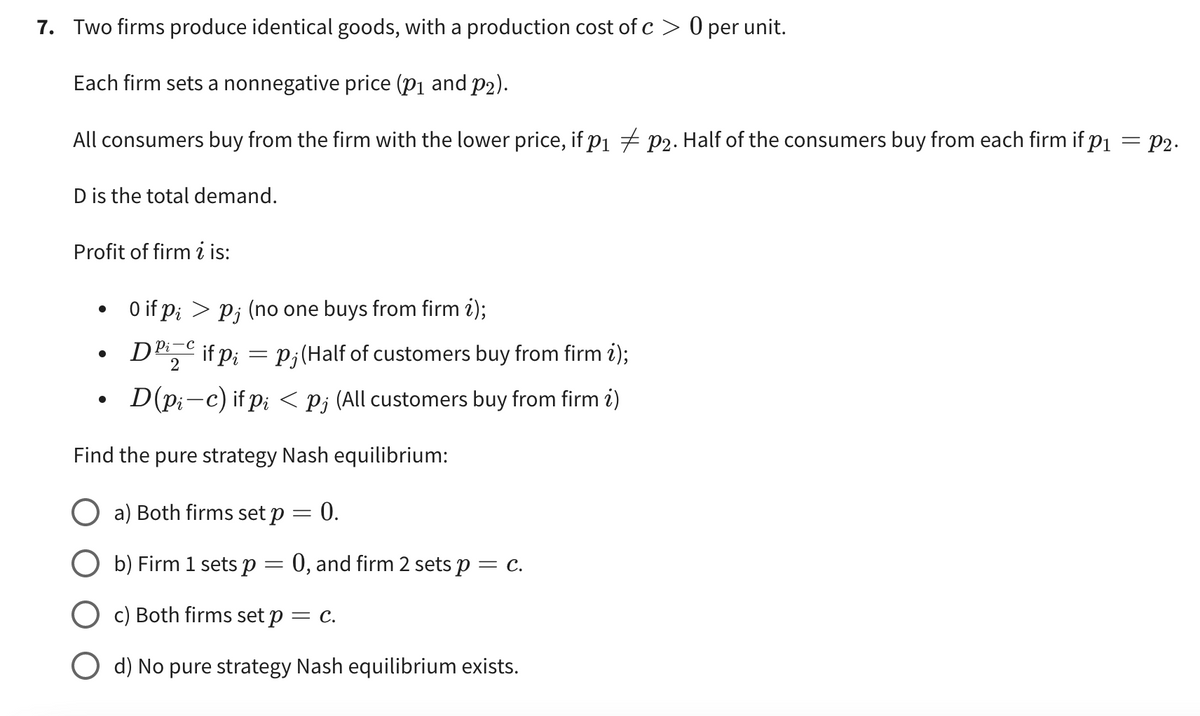7. Two firms produce identical goods, with a production cost of c> 0 per unit. Each firm sets a nonnegative price (p₁ and 2). All consumers buy from the firm with the lower price, if p1 # P2. Half of the consumers buy from each firm if p₁ = P2. D is the total demand. Profit of firm i is: 0 if pi > p; (no one buys from firm i); Pi-c DPC if p₁ = p; (Half of customers buy from firm i); 2 D(pic) if pi < p; (All customers buy from firm 2) Find the pure strategy Nash equilibrium: a) Both firms set p = 0. b) Firm 1 sets p = 0, and firm 2 sets p = c. c) Both firms set p = c. d) No pure strategy Nash equilibrium exists.
7. Two firms produce identical goods, with a production cost of c> 0 per unit. Each firm sets a nonnegative price (p₁ and 2). All consumers buy from the firm with the lower price, if p1 # P2. Half of the consumers buy from each firm if p₁ = P2. D is the total demand. Profit of firm i is: 0 if pi > p; (no one buys from firm i); Pi-c DPC if p₁ = p; (Half of customers buy from firm i); 2 D(pic) if pi < p; (All customers buy from firm 2) Find the pure strategy Nash equilibrium: a) Both firms set p = 0. b) Firm 1 sets p = 0, and firm 2 sets p = c. c) Both firms set p = c. d) No pure strategy Nash equilibrium exists.
Economics: Private and Public Choice (MindTap Course List)
16th Edition
ISBN:9781305506725
Author:James D. Gwartney, Richard L. Stroup, Russell S. Sobel, David A. Macpherson
Publisher:James D. Gwartney, Richard L. Stroup, Russell S. Sobel, David A. Macpherson
Chapter24: Price-searcher Markets With High Entry Barriers
Section: Chapter Questions
Problem 13CQ
Related questions
Question

Transcribed Image Text:7. Two firms produce identical goods, with a production cost of c> 0 per unit.
Each firm sets a nonnegative price (p₁ and p₂).
All consumers buy from the firm with the lower price, if p₁ ‡ p2. Half of the consumers buy from each firm if p₁ = P2.
D is the total demand.
Profit of firm i is:
0 if pi > Pj (no one buys from firm i);
pi-c
●
Die if p₁ = p; (Half of customers buy from firm i);
2
D(pic) if pi < p; (All customers buy from firm i)
Find the pure strategy Nash equilibrium:
a) Both firms set p = 0.
b) Firm 1 sets p = 0, and firm 2 sets p = c.
c) Both firms set p = c.
O d) No pure strategy Nash equilibrium exists.
Expert Solution
This question has been solved!
Explore an expertly crafted, step-by-step solution for a thorough understanding of key concepts.
This is a popular solution!
Trending now
This is a popular solution!
Step by step
Solved in 2 steps

Knowledge Booster
Learn more about
Need a deep-dive on the concept behind this application? Look no further. Learn more about this topic, economics and related others by exploring similar questions and additional content below.Recommended textbooks for you

Economics: Private and Public Choice (MindTap Cou…
Economics
ISBN:
9781305506725
Author:
James D. Gwartney, Richard L. Stroup, Russell S. Sobel, David A. Macpherson
Publisher:
Cengage Learning

Microeconomics: Private and Public Choice (MindTa…
Economics
ISBN:
9781305506893
Author:
James D. Gwartney, Richard L. Stroup, Russell S. Sobel, David A. Macpherson
Publisher:
Cengage Learning

Economics: Private and Public Choice (MindTap Cou…
Economics
ISBN:
9781305506725
Author:
James D. Gwartney, Richard L. Stroup, Russell S. Sobel, David A. Macpherson
Publisher:
Cengage Learning

Microeconomics: Private and Public Choice (MindTa…
Economics
ISBN:
9781305506893
Author:
James D. Gwartney, Richard L. Stroup, Russell S. Sobel, David A. Macpherson
Publisher:
Cengage Learning